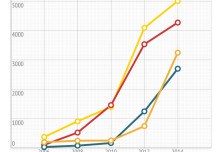
Across the CFO landscape, dozens are dropping the time-honored budget document in favor of different approaches, ranging from tactics such as opting for continuous management to adopting three- to five-year spend targets.
In fact, there is a trend to eliminate the traditional budgeting process altogether, according to a recent article in CFO Magazine.
And it’s no surprise why: The budgeting process can monopolize up to 20 percent of a company’s time and managerial resources, while failing to take into account unforeseen changes in the marketplace. What’s more, most budgets fail to be based on competitive marketplace benchmarks in key categories, and are out of sync with their firm’s procurement strategy—if there is a procurement strategy at all.
At Vantage, we recognize that budgeting is an arduous process. After working with middle market companies for 15 years, we also know that establishing greater spend visibility and employing strategic procurement can breathe new life into your budgeting process.
How? By inserting two key ingredients into the budgeting mix: better, more granular spend data, and by syncing the budgeting process with strategic procurement.
1. Greater spend visibility means more accurate, market-competitive budgets.
The more granular level of data your purchasing department can provide, the better your spend visibility will be. And better spend visibility means more accurate budgeting.
In our work at Vantage, we’ve found that a majority of firms employ highly fragmented data sources for their spend information. Often, CFOs can point to a category where they spent $100,000, but can’t itemize what that bought them. They need access to better spend data, down to the transaction level.
Find out how Vantage Cost can help you obtain better spend data >>
2. Strategic sourcing means more accurate baselines and long-term savings.
Too often, there’s a disconnect when it comes to firms’ finance and procurement departments. For an organization to achieve optimal financial stewardship, it’s key for these two departments to be on the same page when it comes to defining cost-saving metrics and tracking savings.
By employing strategic sourcing—a procurement strategy that goes deeper than the traditional three-bid process—CFOs can ensure that the baselines they use in their budget are competitive across the marketplace, and will boost cost-savings. Too-often, a CFO will obtain competitive rates with suppliers, but fail to work with procurement to ensure those savings are actually realized.
Fragmented spend and procurement data means that savings projections aren’t realized, rendering useless even the most carefully prepared budget. In a global study, 400 supply chain executives agreed that tracking and analyzing this data was their number one challenge.
Find out how Vantage Cost can help track your savings effort >>
The result? Only 34 percent of projected savings from strategic sourcing activities ever materialize, according to a 2005 study by the Aberdeen Group.
At Vantage, we know many firms are afflicted by this disconnect between finance and procurement. That’s why we begin our process by gathering the most granular-level, transaction-by-transaction data, arm ourselves with the most current market research and track cost-reduction results.
By aligning your procurement strategy with your budgeting process, you can rescue your financial forecasting. Yes, budgeting is complicated and sometimes inaccurate. But it can be better. You don’t have to throw the baby out with the bathwater.
How can we provide your company with greater financial stewardship?
photo credit: 401(K) 2013 via photopin cc


